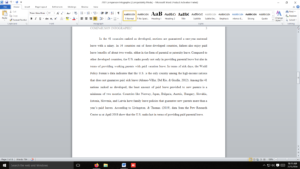Infographic
Create an infographic that compares the U.S. government’s family leave policies with those in the rest of the developed world. In addition to posting your infographic, share your recommendations for how the U.S. could improve its policies and the expected benefits. Be sure to substantiate your comparisons and recommendations with evidence from current scholarly resources.
Just need it by Sunday the 13th, and here are some resources and the textbook.
Brown, M. (2012). Responses to work intensification: Does generation matter?. The International Journal Of Human Resource Management, 23(17), 3578-3595. doi:10.1080/09585192.2011.
Kelly, E. L., Moen, P., Oakes, J. M., Fan, W., Okechukwu, C., Davis, K. D., Hammer, L. B., & Casper, L. M. (2014, May 29). Changing work and work-family conflict: Evidence from the work, family, and health network. American Sociological Review,79(3), 485-516. Retrieved from http://www.researchgate.net/
Mandel, H. (2011). Rethinking the paradox: tradeoffs in work-family policy and patterns of gender inequality. Community, Work & Family, 14(2), 159-176. doi:10.1080/13668803.2011.
Ray, R., Gornick, J. C., & Schmitt, J. (2009). Parental leave policies in 21 countries: Assessing generosity and gender equality. Center for Economic and Policy Research. Retrieved from http://www.cite.gov.pt/
Slaughter, A-M. (2013, June). Anne-Marie Slaughter: Can we have it all? [Video file] Retrieved from: http://www.ted.com/talks/anne_
Valenti, J . (2014, August 20). Lean in, lean out, whatever: working mothers still don’t get enough credit. The Guardian Retrieved from http://www.theguardian.com/
Recommended References
Budig, M. J., Misra, J., & Boekmann, I. (2012). The motherhood penalty in cross-national perspective: The importance of work–family policies and cultural attitudes. Social Politics, 19(2), 163-193. Retrieved from http://paa2012.princeton.edu/
Jorgensen, G. (2006). Kohlberg and Gilligan: Duet or duel?. Journal of Moral Education, 35(2), 179-196. Retrieved from http://www.worldcat.org/title/
and the textbook:
Alonso-Villar, O., Del Rio, C., & Gradin, C. (2012). The extent of occupational segregation in the United States: Differences by race, ethnicity, and gender. Industrial Relations: A Journal of Economy & Society, 51(2), 179-212. doi:10.1111/j.1468-232X.2012.
Answer preview
In the 41 countries ranked as developed, mothers are guaranteed a one-year maternal leave with a salary. In 34 countries out of these developed countries, fathers also enjoy paid leave benefits of about two weeks, either in the form of parental or paternity leave. Compared to other developed countries, the U.S. ranks poorly not only in providing parental leave but also in terms of providing working parents with paid vacation leave. In terms of sick days, the World Policy Forum’s data indicates that the U.S. is the only country among the high-income nations that does not guarantee paid sick leave (Alonso-Villar, Del Rio, & Gradin, 2012). Among the 41 nations ranked as developed, the least amount of paid leave provided to new parents is a minimum of two months. Countries like Norway, Japan, Bulgaria, Austria, Hungary, Slovakia, Estonia, Slovenia, and Latvia have family leave policies that guarantee new parents more than a year’s paid leaves. According to Livingston, & Thomas,
[784 Words]

Infographic

